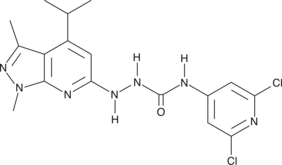Cayman
Showing 25651–25800 of 45550 results
-
The enzyme, fatty acid amide hydrolase (FAAH), is widely expressed in brain and other tissues, and is capable of hydrolyzing anandamide (AEA) and other simple esters and amides with long unsaturated acyl chains.{3110} JP104 is an irreversible fatty acid amide hydrolase (FAAH) inhibitor of the carbamate class with an IC50 of 7.3 nM for the human recombinant enzyme when tested using radiolabeled oleamide as the substrate.{14130} The alkyl derivative on JP104 reacts with azide-modified reporter tags, such as azido-rhodamine or azido-biotin, for visualization of JP104 bound to FAAH in vivo.
Brand:CaymanSKU:10008661 - 5 mgAvailable on backorder
The enzyme, fatty acid amide hydrolase (FAAH), is widely expressed in brain and other tissues, and is capable of hydrolyzing anandamide (AEA) and other simple esters and amides with long unsaturated acyl chains.{3110} JP104 is an irreversible fatty acid amide hydrolase (FAAH) inhibitor of the carbamate class with an IC50 of 7.3 nM for the human recombinant enzyme when tested using radiolabeled oleamide as the substrate.{14130} The alkyl derivative on JP104 reacts with azide-modified reporter tags, such as azido-rhodamine or azido-biotin, for visualization of JP104 bound to FAAH in vivo.
Brand:CaymanSKU:10008661 - 50 mgAvailable on backorder
The enzyme fatty acyl amide hydrolase (FAAH) is widely expressed in brain and other tissues, and is capable of hydrolyzing anandamide (AEA) and other simple esters and amides with long unsaturated acyl chains.{3110} JP83 is an irreversible fatty acyl amide hydrolase (FAAH) inhibitor of the carbamate class with an IC50 of 14 nM for the human recombinant enzyme when tested using radiolabeled oleamide as the substrate.{14130}
Brand:CaymanSKU:10008660 - 10 mgAvailable on backorder
The enzyme fatty acyl amide hydrolase (FAAH) is widely expressed in brain and other tissues, and is capable of hydrolyzing anandamide (AEA) and other simple esters and amides with long unsaturated acyl chains.{3110} JP83 is an irreversible fatty acyl amide hydrolase (FAAH) inhibitor of the carbamate class with an IC50 of 14 nM for the human recombinant enzyme when tested using radiolabeled oleamide as the substrate.{14130}
Brand:CaymanSKU:10008660 - 5 mgAvailable on backorder
The enzyme fatty acyl amide hydrolase (FAAH) is widely expressed in brain and other tissues, and is capable of hydrolyzing anandamide (AEA) and other simple esters and amides with long unsaturated acyl chains.{3110} JP83 is an irreversible fatty acyl amide hydrolase (FAAH) inhibitor of the carbamate class with an IC50 of 14 nM for the human recombinant enzyme when tested using radiolabeled oleamide as the substrate.{14130}
Brand:CaymanSKU:10008660 - 50 mgAvailable on backorder
JPH203 is an inhibitor of L-type amino acid transporter 1 (LAT1; IC50 = 0.14 μM for 14C-leucine uptake in S2 cells expressing the human transporter).{52371} It is selective for LAT1 over LAT2 (IC50 = >10 μM). JPH203 inhibits 14C-leucine uptake by, and growth of, HT-29 cells (IC50s = 0.06 and 4.1 μM, respectively). It induces apoptosis and increases levels of cleaved caspase-3, caspase-7, caspase-9, and poly(ADP-ribose) polymerase (PARP) in YD-38 oral cancer cells when used at a concentration of 3 mM.{52372} JPH203 (6.3, 12.5, and 25 mg/kg) reduces tumor growth in an HT-29 mouse xenograft model.{52371}
Brand:CaymanSKU:29715 - 1 mgAvailable on backorder
JPH203 is an inhibitor of L-type amino acid transporter 1 (LAT1; IC50 = 0.14 μM for 14C-leucine uptake in S2 cells expressing the human transporter).{52371} It is selective for LAT1 over LAT2 (IC50 = >10 μM). JPH203 inhibits 14C-leucine uptake by, and growth of, HT-29 cells (IC50s = 0.06 and 4.1 μM, respectively). It induces apoptosis and increases levels of cleaved caspase-3, caspase-7, caspase-9, and poly(ADP-ribose) polymerase (PARP) in YD-38 oral cancer cells when used at a concentration of 3 mM.{52372} JPH203 (6.3, 12.5, and 25 mg/kg) reduces tumor growth in an HT-29 mouse xenograft model.{52371}
Brand:CaymanSKU:29715 - 10 mgAvailable on backorder
JPH203 is an inhibitor of L-type amino acid transporter 1 (LAT1; IC50 = 0.14 μM for 14C-leucine uptake in S2 cells expressing the human transporter).{52371} It is selective for LAT1 over LAT2 (IC50 = >10 μM). JPH203 inhibits 14C-leucine uptake by, and growth of, HT-29 cells (IC50s = 0.06 and 4.1 μM, respectively). It induces apoptosis and increases levels of cleaved caspase-3, caspase-7, caspase-9, and poly(ADP-ribose) polymerase (PARP) in YD-38 oral cancer cells when used at a concentration of 3 mM.{52372} JPH203 (6.3, 12.5, and 25 mg/kg) reduces tumor growth in an HT-29 mouse xenograft model.{52371}
Brand:CaymanSKU:29715 - 5 mgAvailable on backorder
JQEZ5 is an inhibitor of EZH2 lysine methyltransferase (IC50 = 11.1 nM), the enzymatic subunit of polycomb repressive complex 2 (PRC2).{48431,48432} It inhibits colony formation of primary human CD34+ chronic myelogenous leukemia (CML) stem/progenitor cells but not non-cancerous human CD34+ hematopoietic stem/progenitor cells when used at concentrations ranging from 0.5 to 5 µM.{48432} It also reduces global levels of trimethylated histone 3 lysine 27 (H3K27Me3), a mark that is regulated by PRC2, in K562 cells. JQEZ5 (75 mg/kg per day) induces regression of tumors in an EZH2-driven transgenic mouse model of lung adenocarcinoma.{48431}
Brand:CaymanSKU:27457 - 10 mgAvailable on backorder
JQEZ5 is an inhibitor of EZH2 lysine methyltransferase (IC50 = 11.1 nM), the enzymatic subunit of polycomb repressive complex 2 (PRC2).{48431,48432} It inhibits colony formation of primary human CD34+ chronic myelogenous leukemia (CML) stem/progenitor cells but not non-cancerous human CD34+ hematopoietic stem/progenitor cells when used at concentrations ranging from 0.5 to 5 µM.{48432} It also reduces global levels of trimethylated histone 3 lysine 27 (H3K27Me3), a mark that is regulated by PRC2, in K562 cells. JQEZ5 (75 mg/kg per day) induces regression of tumors in an EZH2-driven transgenic mouse model of lung adenocarcinoma.{48431}
Brand:CaymanSKU:27457 - 25 mgAvailable on backorder
JQEZ5 is an inhibitor of EZH2 lysine methyltransferase (IC50 = 11.1 nM), the enzymatic subunit of polycomb repressive complex 2 (PRC2).{48431,48432} It inhibits colony formation of primary human CD34+ chronic myelogenous leukemia (CML) stem/progenitor cells but not non-cancerous human CD34+ hematopoietic stem/progenitor cells when used at concentrations ranging from 0.5 to 5 µM.{48432} It also reduces global levels of trimethylated histone 3 lysine 27 (H3K27Me3), a mark that is regulated by PRC2, in K562 cells. JQEZ5 (75 mg/kg per day) induces regression of tumors in an EZH2-driven transgenic mouse model of lung adenocarcinoma.{48431}
Brand:CaymanSKU:27457 - 5 mgAvailable on backorder
JQEZ5 is an inhibitor of EZH2 lysine methyltransferase (IC50 = 11.1 nM), the enzymatic subunit of polycomb repressive complex 2 (PRC2).{48431,48432} It inhibits colony formation of primary human CD34+ chronic myelogenous leukemia (CML) stem/progenitor cells but not non-cancerous human CD34+ hematopoietic stem/progenitor cells when used at concentrations ranging from 0.5 to 5 µM.{48432} It also reduces global levels of trimethylated histone 3 lysine 27 (H3K27Me3), a mark that is regulated by PRC2, in K562 cells. JQEZ5 (75 mg/kg per day) induces regression of tumors in an EZH2-driven transgenic mouse model of lung adenocarcinoma.{48431}
Brand:CaymanSKU:27457 - 50 mgAvailable on backorder
JS-K is a nitric oxide (NO) donor that reacts with glutathione to generate NO at physiological pH.{38457} It inhibits proliferation of HL-60 cells (IC50 = 0.5 µM), which is prevented by the glutathione precursor N-acetyl-L-cysteine (Item No. 20261), and inhibits growth of the solid tumor cell lines PPC-1, DLD-1, and Meth A. It decreases tumor volume by over 50% in an HL-60 mouse xenograft model when used at a dose of 4 µmol/kg, i.v., three times per week. JS-K inhibits proliferation, induces apoptosis, and disrupts the cell cycle of Jurkat T acute lymphoblastic leukemia cells.{38456} It also induces S-nitrosylation of β-catenin followed by dose-dependent degradation of nuclear β-catenin and S-nitrosylated nuclear β-catenin levels.
Brand:CaymanSKU:21225 -Out of stock
JS-K is a nitric oxide (NO) donor that reacts with glutathione to generate NO at physiological pH.{38457} It inhibits proliferation of HL-60 cells (IC50 = 0.5 µM), which is prevented by the glutathione precursor N-acetyl-L-cysteine (Item No. 20261), and inhibits growth of the solid tumor cell lines PPC-1, DLD-1, and Meth A. It decreases tumor volume by over 50% in an HL-60 mouse xenograft model when used at a dose of 4 µmol/kg, i.v., three times per week. JS-K inhibits proliferation, induces apoptosis, and disrupts the cell cycle of Jurkat T acute lymphoblastic leukemia cells.{38456} It also induces S-nitrosylation of β-catenin followed by dose-dependent degradation of nuclear β-catenin and S-nitrosylated nuclear β-catenin levels.
Brand:CaymanSKU:21225 -Out of stock
JSH-23 is an inhibitor of NF-κB, blocking its translocation into the nucleus (IC50 = 7.1 µM).{24719} It does not affect degradation of the inhibitor of NF-κB, IκB.{24719} JSH-23 interferes with NF-κB-mediated gene expression and apoptosis in RAW 264.7 cells treated with lipopolysaccharide.{24719} It has also been used to investigate the roles of NF-κB in cancer, inflammation, and neurogenesis.{24722,24720,24721}
Brand:CaymanSKU:-JSH-23 is an inhibitor of NF-κB, blocking its translocation into the nucleus (IC50 = 7.1 µM).{24719} It does not affect degradation of the inhibitor of NF-κB, IκB.{24719} JSH-23 interferes with NF-κB-mediated gene expression and apoptosis in RAW 264.7 cells treated with lipopolysaccharide.{24719} It has also been used to investigate the roles of NF-κB in cancer, inflammation, and neurogenesis.{24722,24720,24721}
Brand:CaymanSKU:-JSH-23 is an inhibitor of NF-κB, blocking its translocation into the nucleus (IC50 = 7.1 µM).{24719} It does not affect degradation of the inhibitor of NF-κB, IκB.{24719} JSH-23 interferes with NF-κB-mediated gene expression and apoptosis in RAW 264.7 cells treated with lipopolysaccharide.{24719} It has also been used to investigate the roles of NF-κB in cancer, inflammation, and neurogenesis.{24722,24720,24721}
Brand:CaymanSKU:-JSH-23 is an inhibitor of NF-κB, blocking its translocation into the nucleus (IC50 = 7.1 µM).{24719} It does not affect degradation of the inhibitor of NF-κB, IκB.{24719} JSH-23 interferes with NF-κB-mediated gene expression and apoptosis in RAW 264.7 cells treated with lipopolysaccharide.{24719} It has also been used to investigate the roles of NF-κB in cancer, inflammation, and neurogenesis.{24722,24720,24721}
Brand:CaymanSKU:-JT010 is a transient receptor potential ankyrin 1 (TRPA1) agonist (EC50 = 0.65 nM in a calcium influx assay).{53241} It is selective for TRPA1 over TRP vanilloid 1 (TRPV1), TRPV3, TRPV4, TRP canonical channel 5 (TRPC5), TRP melastatin 2 (TRPM2), and TRPM8 channels at 1 µM.
Brand:CaymanSKU:29732 - 1 mgAvailable on backorder
JT010 is a transient receptor potential ankyrin 1 (TRPA1) agonist (EC50 = 0.65 nM in a calcium influx assay).{53241} It is selective for TRPA1 over TRP vanilloid 1 (TRPV1), TRPV3, TRPV4, TRP canonical channel 5 (TRPC5), TRP melastatin 2 (TRPM2), and TRPM8 channels at 1 µM.
Brand:CaymanSKU:29732 - 10 mgAvailable on backorder
JT010 is a transient receptor potential ankyrin 1 (TRPA1) agonist (EC50 = 0.65 nM in a calcium influx assay).{53241} It is selective for TRPA1 over TRP vanilloid 1 (TRPV1), TRPV3, TRPV4, TRP canonical channel 5 (TRPC5), TRP melastatin 2 (TRPM2), and TRPM8 channels at 1 µM.
Brand:CaymanSKU:29732 - 5 mgAvailable on backorder
JTC 801 is an antagonist of the nociceptin receptor (ORL1; Ki = 44.5 nM; IC50 = 94 nM) that is >100-, >100-, and >3-fold more selective for ORL1 over the related δ-, κ-, and µ-opioid receptors, respectively.{33471} It demonstrates anti-nociceptive effects in acute pain models in mice upon oral administration at 1 mg/kg.{33471}
Brand:CaymanSKU:21254 -Out of stock
JTC 801 is an antagonist of the nociceptin receptor (ORL1; Ki = 44.5 nM; IC50 = 94 nM) that is >100-, >100-, and >3-fold more selective for ORL1 over the related δ-, κ-, and µ-opioid receptors, respectively.{33471} It demonstrates anti-nociceptive effects in acute pain models in mice upon oral administration at 1 mg/kg.{33471}
Brand:CaymanSKU:21254 -Out of stock
JTC 801 is an antagonist of the nociceptin receptor (ORL1; Ki = 44.5 nM; IC50 = 94 nM) that is >100-, >100-, and >3-fold more selective for ORL1 over the related δ-, κ-, and µ-opioid receptors, respectively.{33471} It demonstrates anti-nociceptive effects in acute pain models in mice upon oral administration at 1 mg/kg.{33471}
Brand:CaymanSKU:21254 -Out of stock
JTC 801 is an antagonist of the nociceptin receptor (ORL1; Ki = 44.5 nM; IC50 = 94 nM) that is >100-, >100-, and >3-fold more selective for ORL1 over the related δ-, κ-, and µ-opioid receptors, respectively.{33471} It demonstrates anti-nociceptive effects in acute pain models in mice upon oral administration at 1 mg/kg.{33471}
Brand:CaymanSKU:21254 -Out of stock
Sphingosine-1-phosphate (S1P) is a bioactive lipid that exhibits a broad spectrum of biological activities including cell proliferation, survival, migration, cytoskeletal organization, and morphogenesis.{11895,12477,10628} It exerts its activity by binding to five distinct G protein-coupled receptors, S1P1/EDG-1, S1P2/EDG-5, S1P3/EDG-3, S1P4/EDG-6, and S1P5/EDG-8.{11895,12477} JTE-013 is a potent, selective sphingosine-1-phosphate 2 (S1P2) receptor antagonist that binds to the human and rat receptors with IC50 values of 17 and 22 nM, respectively, (IC50 values >10 µM for human S1P1 and S1P3).{14560} It reverses the inhibitory effects of S1P on cell migration of vascular endothelial cells and smooth muscle cells. Similarly, JTE-013 reverses the inhibition of S1P on invasion and migration of B16 melanoma cells.{14560,14559} JTE-013 inhibits S1P-induced contraction of, as well as cyclic AMP accumulation in, coronary artery smooth muscle cells.{14558,14556}
Brand:CaymanSKU:10009458 - 1 mgAvailable on backorder
Sphingosine-1-phosphate (S1P) is a bioactive lipid that exhibits a broad spectrum of biological activities including cell proliferation, survival, migration, cytoskeletal organization, and morphogenesis.{11895,12477,10628} It exerts its activity by binding to five distinct G protein-coupled receptors, S1P1/EDG-1, S1P2/EDG-5, S1P3/EDG-3, S1P4/EDG-6, and S1P5/EDG-8.{11895,12477} JTE-013 is a potent, selective sphingosine-1-phosphate 2 (S1P2) receptor antagonist that binds to the human and rat receptors with IC50 values of 17 and 22 nM, respectively, (IC50 values >10 µM for human S1P1 and S1P3).{14560} It reverses the inhibitory effects of S1P on cell migration of vascular endothelial cells and smooth muscle cells. Similarly, JTE-013 reverses the inhibition of S1P on invasion and migration of B16 melanoma cells.{14560,14559} JTE-013 inhibits S1P-induced contraction of, as well as cyclic AMP accumulation in, coronary artery smooth muscle cells.{14558,14556}
Brand:CaymanSKU:10009458 - 10 mgAvailable on backorder
Sphingosine-1-phosphate (S1P) is a bioactive lipid that exhibits a broad spectrum of biological activities including cell proliferation, survival, migration, cytoskeletal organization, and morphogenesis.{11895,12477,10628} It exerts its activity by binding to five distinct G protein-coupled receptors, S1P1/EDG-1, S1P2/EDG-5, S1P3/EDG-3, S1P4/EDG-6, and S1P5/EDG-8.{11895,12477} JTE-013 is a potent, selective sphingosine-1-phosphate 2 (S1P2) receptor antagonist that binds to the human and rat receptors with IC50 values of 17 and 22 nM, respectively, (IC50 values >10 µM for human S1P1 and S1P3).{14560} It reverses the inhibitory effects of S1P on cell migration of vascular endothelial cells and smooth muscle cells. Similarly, JTE-013 reverses the inhibition of S1P on invasion and migration of B16 melanoma cells.{14560,14559} JTE-013 inhibits S1P-induced contraction of, as well as cyclic AMP accumulation in, coronary artery smooth muscle cells.{14558,14556}
Brand:CaymanSKU:10009458 - 5 mgAvailable on backorder
Sphingosine-1-phosphate (S1P) is a bioactive lipid that exhibits a broad spectrum of biological activities including cell proliferation, survival, migration, cytoskeletal organization, and morphogenesis.{11895,12477,10628} It exerts its activity by binding to five distinct G protein-coupled receptors, S1P1/EDG-1, S1P2/EDG-5, S1P3/EDG-3, S1P4/EDG-6, and S1P5/EDG-8.{11895,12477} JTE-013 is a potent, selective sphingosine-1-phosphate 2 (S1P2) receptor antagonist that binds to the human and rat receptors with IC50 values of 17 and 22 nM, respectively, (IC50 values >10 µM for human S1P1 and S1P3).{14560} It reverses the inhibitory effects of S1P on cell migration of vascular endothelial cells and smooth muscle cells. Similarly, JTE-013 reverses the inhibition of S1P on invasion and migration of B16 melanoma cells.{14560,14559} JTE-013 inhibits S1P-induced contraction of, as well as cyclic AMP accumulation in, coronary artery smooth muscle cells.{14558,14556}
Brand:CaymanSKU:10009458 - 50 mgAvailable on backorder
JTE-907 is a selective peripheral cannabinoid (CB2) receptor agonist with Kd values of 25 and 2,370, 1.55 and 1,060, and 0.38 and 1,050 nM for human, mouse, and rat CB2 and CB1 receptors, respectively.{14732} It increases forskolin-stimulated cAMP production in CHO cells expressing human and mouse CB2 in a dose-dependent manner. In vivo, JTE-907 inhibits carrageenin-induced edema in mouse paws with an ED50 value of 0.05 mg/kg. JTE-907 also inhibits spontaneous scratching in a mouse model of chronic dermatitis at doses of 1 and 10 mg/kg.{14731}
Brand:CaymanSKU:10009857 - 1 mgAvailable on backorder
JTE-907 is a selective peripheral cannabinoid (CB2) receptor agonist with Kd values of 25 and 2,370, 1.55 and 1,060, and 0.38 and 1,050 nM for human, mouse, and rat CB2 and CB1 receptors, respectively.{14732} It increases forskolin-stimulated cAMP production in CHO cells expressing human and mouse CB2 in a dose-dependent manner. In vivo, JTE-907 inhibits carrageenin-induced edema in mouse paws with an ED50 value of 0.05 mg/kg. JTE-907 also inhibits spontaneous scratching in a mouse model of chronic dermatitis at doses of 1 and 10 mg/kg.{14731}
Brand:CaymanSKU:10009857 - 5 mgAvailable on backorder
Juglone is a natural naphthoquinone found in the black walnut (J. nigra) and other plants in the Juglandaceae family. It has allelopathic actions, suppressing growth, photosynthesis, and respiration in plants and other organisms, although some bacteria can metabolize juglone.{26429,26432} Juglone also irreversibly inhibits peptidyl-prolyl cis/trans isomerases of the parvulin family, including human Pin1, yeast Ess1/Ptf1, and E. coli parvulin (Ki = 55.9 nM).{26430} Juglone also blocks transcription by RNA polymerases I, II, and III (IC50s = 2-7 µM) and attenuates kidney fibrosis in rats treated with unilateral ureteral obstruction, both through Pin1-independent mechanisms.{26433,26431}
Brand:CaymanSKU:-Juglone is a natural naphthoquinone found in the black walnut (J. nigra) and other plants in the Juglandaceae family. It has allelopathic actions, suppressing growth, photosynthesis, and respiration in plants and other organisms, although some bacteria can metabolize juglone.{26429,26432} Juglone also irreversibly inhibits peptidyl-prolyl cis/trans isomerases of the parvulin family, including human Pin1, yeast Ess1/Ptf1, and E. coli parvulin (Ki = 55.9 nM).{26430} Juglone also blocks transcription by RNA polymerases I, II, and III (IC50s = 2-7 µM) and attenuates kidney fibrosis in rats treated with unilateral ureteral obstruction, both through Pin1-independent mechanisms.{26433,26431}
Brand:CaymanSKU:-Juvenile hormone III is an acyclic sesquiterpenoid that regulates diverse processes in insects, including adult transition of larvae and oogenesis in adult females.{31418,27673} It activates the juvenile hormone receptor, known as methoprene-tolerant, with a Kd value of 2.9 nM.{27673} Juvenile hormone III can be synthesized from farnesoic acid by two alternative pathways, one through methyl farnesoate and the other through juvenile hormone acid III.{31416,31417}
Brand:CaymanSKU:19646 -Available on backorder
Juvenile hormone III is an acyclic sesquiterpenoid that regulates diverse processes in insects, including adult transition of larvae and oogenesis in adult females.{31418,27673} It activates the juvenile hormone receptor, known as methoprene-tolerant, with a Kd value of 2.9 nM.{27673} Juvenile hormone III can be synthesized from farnesoic acid by two alternative pathways, one through methyl farnesoate and the other through juvenile hormone acid III.{31416,31417}
Brand:CaymanSKU:19646 -Available on backorder
Juvenile hormone III is an acyclic sesquiterpenoid that regulates diverse processes in insects, including adult transition of larvae and oogenesis in adult females.{31418,27673} It activates the juvenile hormone receptor, known as methoprene-tolerant, with a Kd value of 2.9 nM.{27673} Juvenile hormone III can be synthesized from farnesoic acid by two alternative pathways, one through methyl farnesoate and the other through juvenile hormone acid III.{31416,31417}
Brand:CaymanSKU:19646 -Available on backorder
The transmembrane enzyme KIAA1363 (also known as AADACL1) controls the production of the monoalkylglycerol ether (MAGE) class of neutral ether lipids (NELs) in cancer cells.{14603} Hyperactivity of this 2-acetyl MAGE hydrolase is associated with tumor cell migration, invasion, survival, and growth.{19445} JW 480 acts as a potent, selective inhibitor of KIAA1361 (IC50s = 20 nM in mouse brain membrane proteomes and 6-12 nM in human PC3 prostate cancer cell proteomes), showing little cross reactivity with hormone-sensitive lipase, acetylcholinesterase, or other serine hydrolases.{19445} JW 480 is active in vivo, reducing PC3 tumor xenograft growth in immune-deficient SCID mice at an oral dose of 80 mg/kg.{19445}
Brand:CaymanSKU:10879 - 10 mgAvailable on backorder
The transmembrane enzyme KIAA1363 (also known as AADACL1) controls the production of the monoalkylglycerol ether (MAGE) class of neutral ether lipids (NELs) in cancer cells.{14603} Hyperactivity of this 2-acetyl MAGE hydrolase is associated with tumor cell migration, invasion, survival, and growth.{19445} JW 480 acts as a potent, selective inhibitor of KIAA1361 (IC50s = 20 nM in mouse brain membrane proteomes and 6-12 nM in human PC3 prostate cancer cell proteomes), showing little cross reactivity with hormone-sensitive lipase, acetylcholinesterase, or other serine hydrolases.{19445} JW 480 is active in vivo, reducing PC3 tumor xenograft growth in immune-deficient SCID mice at an oral dose of 80 mg/kg.{19445}
Brand:CaymanSKU:10879 - 25 mgAvailable on backorder
The transmembrane enzyme KIAA1363 (also known as AADACL1) controls the production of the monoalkylglycerol ether (MAGE) class of neutral ether lipids (NELs) in cancer cells.{14603} Hyperactivity of this 2-acetyl MAGE hydrolase is associated with tumor cell migration, invasion, survival, and growth.{19445} JW 480 acts as a potent, selective inhibitor of KIAA1361 (IC50s = 20 nM in mouse brain membrane proteomes and 6-12 nM in human PC3 prostate cancer cell proteomes), showing little cross reactivity with hormone-sensitive lipase, acetylcholinesterase, or other serine hydrolases.{19445} JW 480 is active in vivo, reducing PC3 tumor xenograft growth in immune-deficient SCID mice at an oral dose of 80 mg/kg.{19445}
Brand:CaymanSKU:10879 - 5 mgAvailable on backorder
The transmembrane enzyme KIAA1363 (also known as AADACL1) controls the production of the monoalkylglycerol ether (MAGE) class of neutral ether lipids (NELs) in cancer cells.{14603} Hyperactivity of this 2-acetyl MAGE hydrolase is associated with tumor cell migration, invasion, survival, and growth.{19445} JW 480 acts as a potent, selective inhibitor of KIAA1361 (IC50s = 20 nM in mouse brain membrane proteomes and 6-12 nM in human PC3 prostate cancer cell proteomes), showing little cross reactivity with hormone-sensitive lipase, acetylcholinesterase, or other serine hydrolases.{19445} JW 480 is active in vivo, reducing PC3 tumor xenograft growth in immune-deficient SCID mice at an oral dose of 80 mg/kg.{19445}
Brand:CaymanSKU:10879 - 50 mgAvailable on backorder
JW 55 is an inhibitor of the PARP domain of tankyrases (TNKS) 1 and 2 (IC50s = 1.9 and 0.83 µM, respectively).{32617} By inhibiting TNKS1/2, JW 55 stabilizes Axin2 and increases degradation of β-catenin, inhibiting the β-catenin signaling pathway (IC50 = 470 nM).{32617} It has been shown to decrease canonical Wnt signaling in SW480 and HCT15 colon carcinoma cell lines and to reduce proliferation of SW480 cells in vitro.{32617}
Brand:CaymanSKU:-JW 55 is an inhibitor of the PARP domain of tankyrases (TNKS) 1 and 2 (IC50s = 1.9 and 0.83 µM, respectively).{32617} By inhibiting TNKS1/2, JW 55 stabilizes Axin2 and increases degradation of β-catenin, inhibiting the β-catenin signaling pathway (IC50 = 470 nM).{32617} It has been shown to decrease canonical Wnt signaling in SW480 and HCT15 colon carcinoma cell lines and to reduce proliferation of SW480 cells in vitro.{32617}
Brand:CaymanSKU:-JW 55 is an inhibitor of the PARP domain of tankyrases (TNKS) 1 and 2 (IC50s = 1.9 and 0.83 µM, respectively).{32617} By inhibiting TNKS1/2, JW 55 stabilizes Axin2 and increases degradation of β-catenin, inhibiting the β-catenin signaling pathway (IC50 = 470 nM).{32617} It has been shown to decrease canonical Wnt signaling in SW480 and HCT15 colon carcinoma cell lines and to reduce proliferation of SW480 cells in vitro.{32617}
Brand:CaymanSKU:-Endocannabinoids such as 2-arachidonoyl glycerol (2-AG) and arachidonoyl ethanolamide are biologically active lipids that are involved in a number of synaptic processes including activation of cannabinoid receptors. Monoacylglycerol lipase (MAGL) is a serine hydrolase responsible for the hydrolysis of 2-AG to arachidonic acid and glycerol, thus terminating its biological function. JW 618 is an inhibitor of MAGL that displays IC50 values of 123, 385, and 6.9 nM for inhibition of MAGL in mouse, rat, and human brain membranes, respectively.{20923} JW 618 is selective for MAGL, requiring much higher concentrations to effectively inhibit fatty acid amide hydrolase activity (IC50s all > 50 µM for mouse, rat, and human brain membranes).{20923}
Brand:CaymanSKU:11790 - 10 mgAvailable on backorder
Endocannabinoids such as 2-arachidonoyl glycerol (2-AG) and arachidonoyl ethanolamide are biologically active lipids that are involved in a number of synaptic processes including activation of cannabinoid receptors. Monoacylglycerol lipase (MAGL) is a serine hydrolase responsible for the hydrolysis of 2-AG to arachidonic acid and glycerol, thus terminating its biological function. JW 618 is an inhibitor of MAGL that displays IC50 values of 123, 385, and 6.9 nM for inhibition of MAGL in mouse, rat, and human brain membranes, respectively.{20923} JW 618 is selective for MAGL, requiring much higher concentrations to effectively inhibit fatty acid amide hydrolase activity (IC50s all > 50 µM for mouse, rat, and human brain membranes).{20923}
Brand:CaymanSKU:11790 - 25 mgAvailable on backorder
Endocannabinoids such as 2-arachidonoyl glycerol (2-AG) and arachidonoyl ethanolamide are biologically active lipids that are involved in a number of synaptic processes including activation of cannabinoid receptors. Monoacylglycerol lipase (MAGL) is a serine hydrolase responsible for the hydrolysis of 2-AG to arachidonic acid and glycerol, thus terminating its biological function. JW 618 is an inhibitor of MAGL that displays IC50 values of 123, 385, and 6.9 nM for inhibition of MAGL in mouse, rat, and human brain membranes, respectively.{20923} JW 618 is selective for MAGL, requiring much higher concentrations to effectively inhibit fatty acid amide hydrolase activity (IC50s all > 50 µM for mouse, rat, and human brain membranes).{20923}
Brand:CaymanSKU:11790 - 5 mgAvailable on backorder
Endocannabinoids such as 2-arachidonoyl glycerol (2-AG) and arachidonoyl ethanolamide are biologically active lipids that are involved in a number of synaptic processes including activation of cannabinoid receptors. Monoacylglycerol lipase (MAGL) is a serine hydrolase responsible for the hydrolysis of 2-AG to arachidonic acid and glycerol, thus terminating its biological function. JW 618 is an inhibitor of MAGL that displays IC50 values of 123, 385, and 6.9 nM for inhibition of MAGL in mouse, rat, and human brain membranes, respectively.{20923} JW 618 is selective for MAGL, requiring much higher concentrations to effectively inhibit fatty acid amide hydrolase activity (IC50s all > 50 µM for mouse, rat, and human brain membranes).{20923}
Brand:CaymanSKU:11790 - 50 mgAvailable on backorder
Endocannabinoids such as 2-arachidonoyl glycerol (2-AG) and arachidonoyl ethanolamide are biologically active lipids that are involved in a number of synaptic processes including activation of cannabinoid receptors. Monoacylglycerol lipase (MAGL) is a serine hydrolase responsible for the hydrolysis of 2-AG to arachidonic acid and glycerol, thus terminating its biological function. JW 642 is a potent inhibitor of monoacylglycerol lipase (MAGL) that displays IC50 values of 7.6, 14, and 3.7 nM for inhibition of MAGL in mouse, rat, and human brain membranes, respectively.{20923} JW 642 is selective for MAGL, requiring much higher concentrations to effectively inhibit fatty acid amide hydrolase activity (IC50s = 31, 14, and 20.6 µM for mouse, rat, and human brain membranes, respectively).{20923}
Brand:CaymanSKU:11789 - 10 mgAvailable on backorder
Endocannabinoids such as 2-arachidonoyl glycerol (2-AG) and arachidonoyl ethanolamide are biologically active lipids that are involved in a number of synaptic processes including activation of cannabinoid receptors. Monoacylglycerol lipase (MAGL) is a serine hydrolase responsible for the hydrolysis of 2-AG to arachidonic acid and glycerol, thus terminating its biological function. JW 642 is a potent inhibitor of monoacylglycerol lipase (MAGL) that displays IC50 values of 7.6, 14, and 3.7 nM for inhibition of MAGL in mouse, rat, and human brain membranes, respectively.{20923} JW 642 is selective for MAGL, requiring much higher concentrations to effectively inhibit fatty acid amide hydrolase activity (IC50s = 31, 14, and 20.6 µM for mouse, rat, and human brain membranes, respectively).{20923}
Brand:CaymanSKU:11789 - 100 mgAvailable on backorder
Endocannabinoids such as 2-arachidonoyl glycerol (2-AG) and arachidonoyl ethanolamide are biologically active lipids that are involved in a number of synaptic processes including activation of cannabinoid receptors. Monoacylglycerol lipase (MAGL) is a serine hydrolase responsible for the hydrolysis of 2-AG to arachidonic acid and glycerol, thus terminating its biological function. JW 642 is a potent inhibitor of monoacylglycerol lipase (MAGL) that displays IC50 values of 7.6, 14, and 3.7 nM for inhibition of MAGL in mouse, rat, and human brain membranes, respectively.{20923} JW 642 is selective for MAGL, requiring much higher concentrations to effectively inhibit fatty acid amide hydrolase activity (IC50s = 31, 14, and 20.6 µM for mouse, rat, and human brain membranes, respectively).{20923}
Brand:CaymanSKU:11789 - 5 mgAvailable on backorder
Endocannabinoids such as 2-arachidonoyl glycerol (2-AG) and arachidonoyl ethanolamide are biologically active lipids that are involved in a number of synaptic processes including activation of cannabinoid receptors. Monoacylglycerol lipase (MAGL) is a serine hydrolase responsible for the hydrolysis of 2-AG to arachidonic acid and glycerol, thus terminating its biological function. JW 642 is a potent inhibitor of monoacylglycerol lipase (MAGL) that displays IC50 values of 7.6, 14, and 3.7 nM for inhibition of MAGL in mouse, rat, and human brain membranes, respectively.{20923} JW 642 is selective for MAGL, requiring much higher concentrations to effectively inhibit fatty acid amide hydrolase activity (IC50s = 31, 14, and 20.6 µM for mouse, rat, and human brain membranes, respectively).{20923}
Brand:CaymanSKU:11789 - 50 mgAvailable on backorder
Tankyrases (TNKS) are poly(ADP-ribose) polymerases (PARPs) that cleave NAD+ to produce nicotinamide and ADP-ribose, which is then covalently attached to an acceptor protein in a process known as poly(ADP-ribosyl)ation. TNKS have key roles in the Wnt signaling pathway as part of the β-catenin destruction complex. JW 74 is an inhibitor of the catalytic PARP domain of TNKS1/2 that blocks canonical Wnt signaling with an IC50 value of 790 nM.{30990,30991} It increases the levels of Axin2 and decreases β-catenin levels in colorectal cancer (CRC) cells, leading to down-regulation of Wnt target genes.{30991} JW 74 inhibits the growth of CRC xenograft tumors in mice.{30991} JW 74 induces apoptosis and differentiation in osteosarcoma cell lines.{30990}
Brand:CaymanSKU:-Available on backorder
Tankyrases (TNKS) are poly(ADP-ribose) polymerases (PARPs) that cleave NAD+ to produce nicotinamide and ADP-ribose, which is then covalently attached to an acceptor protein in a process known as poly(ADP-ribosyl)ation. TNKS have key roles in the Wnt signaling pathway as part of the β-catenin destruction complex. JW 74 is an inhibitor of the catalytic PARP domain of TNKS1/2 that blocks canonical Wnt signaling with an IC50 value of 790 nM.{30990,30991} It increases the levels of Axin2 and decreases β-catenin levels in colorectal cancer (CRC) cells, leading to down-regulation of Wnt target genes.{30991} JW 74 inhibits the growth of CRC xenograft tumors in mice.{30991} JW 74 induces apoptosis and differentiation in osteosarcoma cell lines.{30990}
Brand:CaymanSKU:-Available on backorder
Tankyrases (TNKS) are poly(ADP-ribose) polymerases (PARPs) that cleave NAD+ to produce nicotinamide and ADP-ribose, which is then covalently attached to an acceptor protein in a process known as poly(ADP-ribosyl)ation. TNKS have key roles in the Wnt signaling pathway as part of the β-catenin destruction complex. JW 74 is an inhibitor of the catalytic PARP domain of TNKS1/2 that blocks canonical Wnt signaling with an IC50 value of 790 nM.{30990,30991} It increases the levels of Axin2 and decreases β-catenin levels in colorectal cancer (CRC) cells, leading to down-regulation of Wnt target genes.{30991} JW 74 inhibits the growth of CRC xenograft tumors in mice.{30991} JW 74 induces apoptosis and differentiation in osteosarcoma cell lines.{30990}
Brand:CaymanSKU:-Available on backorder
JWH 007 is a potent cannabinoid (CB) receptor agonist that avidly binds to both CB1 and CB2 (Ki = 9.5 and 2.9 nM, respectively).{18231,18232} This compares favorably with the binding of Δ9-THC, which binds CB1 and CB2 with Ki values of 41 and 36 nM, respectively.{18232} Similarly, JWH 007 performs comparably to Δ9-THC in mouse studies on spontaneous activity, antinociception, hypothermia, and catalepsy.{18231}
Brand:CaymanSKU:10266 - 10 mgAvailable on backorder
JWH 007 is a potent cannabinoid (CB) receptor agonist that avidly binds to both CB1 and CB2 (Ki = 9.5 and 2.9 nM, respectively).{18231,18232} This compares favorably with the binding of Δ9-THC, which binds CB1 and CB2 with Ki values of 41 and 36 nM, respectively.{18232} Similarly, JWH 007 performs comparably to Δ9-THC in mouse studies on spontaneous activity, antinociception, hypothermia, and catalepsy.{18231}
Brand:CaymanSKU:10266 - 25 mgAvailable on backorder
JWH 007 is a potent cannabinoid (CB) receptor agonist that avidly binds to both CB1 and CB2 (Ki = 9.5 and 2.9 nM, respectively).{18231,18232} This compares favorably with the binding of Δ9-THC, which binds CB1 and CB2 with Ki values of 41 and 36 nM, respectively.{18232} Similarly, JWH 007 performs comparably to Δ9-THC in mouse studies on spontaneous activity, antinociception, hypothermia, and catalepsy.{18231}
Brand:CaymanSKU:10266 - 5 mgAvailable on backorder
JWH 007-d9 contains nine deuterium atoms at the 2, 2’, 3, 3’, 4, 4’, 5, 5, and 5 positions. It is intended for use as an internal standard for the quantification of JWH 007 by GC- or LC-mass spectrometry (MS). JWH 007 is a potent cannabinoid (CB) receptor agonist that avidly binds to both CB1 and CB2 (Ki = 9.5 and 2.9 nM, respectively).{18231,18232} This compares favorably with the binding of Δ9-THC, which binds CB1 and CB2 with Ki values of 41 and 36 nM, respectively.{18232} Similarly, JWH 007 performs comparably to Δ9-THC in murine studies on spontaneous activity, antinociception, hypothermia, and catalepsy.{18231}
Brand:CaymanSKU:10486 - 1 mgAvailable on backorder
JWH 007-d9 contains nine deuterium atoms at the 2, 2’, 3, 3’, 4, 4’, 5, 5, and 5 positions. It is intended for use as an internal standard for the quantification of JWH 007 by GC- or LC-mass spectrometry (MS). JWH 007 is a potent cannabinoid (CB) receptor agonist that avidly binds to both CB1 and CB2 (Ki = 9.5 and 2.9 nM, respectively).{18231,18232} This compares favorably with the binding of Δ9-THC, which binds CB1 and CB2 with Ki values of 41 and 36 nM, respectively.{18232} Similarly, JWH 007 performs comparably to Δ9-THC in murine studies on spontaneous activity, antinociception, hypothermia, and catalepsy.{18231}
Brand:CaymanSKU:10486 - 500 µgAvailable on backorder
JWH 011 is a synthetic cannabinoid (CB). This N-(1-methylhexyl) compound is analogous to the N-hexyl JWH 004, also a 2-methyl indole, which has high affinities for both central CB1 and peripheral CB2 receptors (Ki = 48 and 4.02 nM, respectively).{16797} This product is intended for forensic and research applications.
Brand:CaymanSKU:9001058 - 1 mgAvailable on backorder
JWH 011 is a synthetic cannabinoid (CB). This N-(1-methylhexyl) compound is analogous to the N-hexyl JWH 004, also a 2-methyl indole, which has high affinities for both central CB1 and peripheral CB2 receptors (Ki = 48 and 4.02 nM, respectively).{16797} This product is intended for forensic and research applications.
Brand:CaymanSKU:9001058 - 10 mgAvailable on backorder
JWH 011 is a synthetic cannabinoid (CB). This N-(1-methylhexyl) compound is analogous to the N-hexyl JWH 004, also a 2-methyl indole, which has high affinities for both central CB1 and peripheral CB2 receptors (Ki = 48 and 4.02 nM, respectively).{16797} This product is intended for forensic and research applications.
Brand:CaymanSKU:9001058 - 25 mgAvailable on backorder
JWH 011 is a synthetic cannabinoid (CB). This N-(1-methylhexyl) compound is analogous to the N-hexyl JWH 004, also a 2-methyl indole, which has high affinities for both central CB1 and peripheral CB2 receptors (Ki = 48 and 4.02 nM, respectively).{16797} This product is intended for forensic and research applications.
Brand:CaymanSKU:9001058 - 5 mgAvailable on backorder
JWH 015-d7 contains seven deuterium atoms at the 1, 1′, 2, 2′, 3, 3, and 3 positions. It is intended for use as an internal standard for the quantification of JWH 015 by GC- or LC-mass spectrometry (MS). JWH 015 is a selective aminoalkylindole peripheral cannabinoid (CB2) receptor agonist with Ki values of 13.8 and 383 nM for human recombinant CB2 and CB1 receptors, respectively.{7912} Using Theiler’s murine encephalomyelitis virus as a model for human multiple sclerosis, treatment with WIN 55,212-2, ACEA, and JWH 015 significantly improved the neurological deficit of established disease.{14364} JWH 015 was shown to reduce microglial activation, abrogate antigen expression, and decrease the number of CD4+ infiltrating T-cells in the spinal cord. In addition, JWH 015 reduces IFN-γ-induced up-regulation of CD40 expression in mouse microglial cells by interfering with the JAK/STAT1 pathway.{14363}
Brand:CaymanSKU:10660 - 1 mgAvailable on backorder
JWH 015-d7 contains seven deuterium atoms at the 1, 1′, 2, 2′, 3, 3, and 3 positions. It is intended for use as an internal standard for the quantification of JWH 015 by GC- or LC-mass spectrometry (MS). JWH 015 is a selective aminoalkylindole peripheral cannabinoid (CB2) receptor agonist with Ki values of 13.8 and 383 nM for human recombinant CB2 and CB1 receptors, respectively.{7912} Using Theiler’s murine encephalomyelitis virus as a model for human multiple sclerosis, treatment with WIN 55,212-2, ACEA, and JWH 015 significantly improved the neurological deficit of established disease.{14364} JWH 015 was shown to reduce microglial activation, abrogate antigen expression, and decrease the number of CD4+ infiltrating T-cells in the spinal cord. In addition, JWH 015 reduces IFN-γ-induced up-regulation of CD40 expression in mouse microglial cells by interfering with the JAK/STAT1 pathway.{14363}
Brand:CaymanSKU:10660 - 500 µgAvailable on backorder
JWH 016 (Item No. 10849) is an analytical reference standard categorized as a synthetic cannabinoid.{16797,16798} JWH 016 induces discriminative stimulus effects in rhesus monkeys comparable to those induced by Δ9-THC (Item Nos. ISO60157 | 12068).{53977} This product is intended for research and forensic applications.
Brand:CaymanSKU:10849 - 10 mgAvailable on backorder
JWH 016 (Item No. 10849) is an analytical reference standard categorized as a synthetic cannabinoid.{16797,16798} JWH 016 induces discriminative stimulus effects in rhesus monkeys comparable to those induced by Δ9-THC (Item Nos. ISO60157 | 12068).{53977} This product is intended for research and forensic applications.
Brand:CaymanSKU:10849 - 25 mgAvailable on backorder
JWH 016 (Item No. 10849) is an analytical reference standard categorized as a synthetic cannabinoid.{16797,16798} JWH 016 induces discriminative stimulus effects in rhesus monkeys comparable to those induced by Δ9-THC (Item Nos. ISO60157 | 12068).{53977} This product is intended for research and forensic applications.
Brand:CaymanSKU:10849 - 5 mgAvailable on backorder
JWH 018 (exempt preparation) (Item No. 13169) is an analytical reference standard categorized as a synthetic cannabinoid.{29530} JWH 018 has been found in Spice/K2-type herbal blends and may have neurotoxic properties. JWH 018 is regulated as a Schedule I compound in the United States. JWH 018 (exempt preparation) (Item No. 13169) is provided as a DEA exempt preparation. This product is intended for research and forensic applications.
Brand:CaymanSKU:-JWH 018 (exempt preparation) (Item No. 13169) is an analytical reference standard categorized as a synthetic cannabinoid.{29530} JWH 018 has been found in Spice/K2-type herbal blends and may have neurotoxic properties. JWH 018 is regulated as a Schedule I compound in the United States. JWH 018 (exempt preparation) (Item No. 13169) is provided as a DEA exempt preparation. This product is intended for research and forensic applications.
Brand:CaymanSKU:-JWH 018 (exempt preparation) (Item No. 13169) is an analytical reference standard categorized as a synthetic cannabinoid.{29530} JWH 018 has been found in Spice/K2-type herbal blends and may have neurotoxic properties. JWH 018 is regulated as a Schedule I compound in the United States. JWH 018 (exempt preparation) (Item No. 13169) is provided as a DEA exempt preparation. This product is intended for research and forensic applications.
Brand:CaymanSKU:-JWH 018 2-hydroxyindole metabolite is a potential monohydroxylated urinary metabolite of JWH 018, a WIN 55,212-2 derivative that is a mildly selective agonist of the peripheral cannabinoid receptor.{18291}
Brand:CaymanSKU:9000844 - 1 mgAvailable on backorder
JWH 018 2-hydroxyindole metabolite is a potential monohydroxylated urinary metabolite of JWH 018, a WIN 55,212-2 derivative that is a mildly selective agonist of the peripheral cannabinoid receptor.{18291}
Brand:CaymanSKU:9000844 - 10 mgAvailable on backorder
JWH 018 2-hydroxyindole metabolite is a potential monohydroxylated urinary metabolite of JWH 018, a WIN 55,212-2 derivative that is a mildly selective agonist of the peripheral cannabinoid receptor.{18291}
Brand:CaymanSKU:9000844 - 5 mgAvailable on backorder
JWH 018 is a synthetic cannabinoid (CB) that potently activates the central CB1 and peripheral CB2 receptors (Ki = 9.0 and 2.94 nM, respectively).{16797} This cannabimimetic compound has frequently been found in herbal blends.{18620,18621,18618} JWH 018 2’-naphthyl isomer differs structurally from JWH 018 by having the naphthyl group attached at the 2’ position. The biological activities of this compound have not been characterized.
Brand:CaymanSKU:9001004 - 1 mgAvailable on backorder
JWH 018 is a synthetic cannabinoid (CB) that potently activates the central CB1 and peripheral CB2 receptors (Ki = 9.0 and 2.94 nM, respectively).{16797} This cannabimimetic compound has frequently been found in herbal blends.{18620,18621,18618} JWH 018 2’-naphthyl isomer differs structurally from JWH 018 by having the naphthyl group attached at the 2’ position. The biological activities of this compound have not been characterized.
Brand:CaymanSKU:9001004 - 10 mgAvailable on backorder
JWH 018 is a synthetic cannabinoid (CB) that potently activates the central CB1 and peripheral CB2 receptors (Ki = 9.0 and 2.94 nM, respectively).{16797} This cannabimimetic compound has frequently been found in herbal blends.{18620,18621,18618} JWH 018 2’-naphthyl isomer differs structurally from JWH 018 by having the naphthyl group attached at the 2’ position. The biological activities of this compound have not been characterized.
Brand:CaymanSKU:9001004 - 5 mgAvailable on backorder
JWH 018 is a synthetic cannabinoid (CB) that potently activates the central cannabinoid (CB1) and peripheral cannabinoid (CB2) receptors (Ki = 9.0 and 2.94 nM, respectively).{16797} This cannabimimetic compound has frequently been found in herbal blends. {18620,18621,18618} JWH 018 2’-naphthyl-N-(1,1-dimethylpropyl) isomer differs from JWH 018 structurally by having a 1,1-dimethylpropyl chain, rather than a pentyl chain, extending from the indole group and the naphthyl moiety attached at its 2 position. The biological activities of this compound have not been characterized. This product is intended for forensic purposes.
Brand:CaymanSKU:9001007 - 1 mgAvailable on backorder
JWH 018 is a synthetic cannabinoid (CB) that potently activates the central cannabinoid (CB1) and peripheral cannabinoid (CB2) receptors (Ki = 9.0 and 2.94 nM, respectively).{16797} This cannabimimetic compound has frequently been found in herbal blends. {18620,18621,18618} JWH 018 2’-naphthyl-N-(1,1-dimethylpropyl) isomer differs from JWH 018 structurally by having a 1,1-dimethylpropyl chain, rather than a pentyl chain, extending from the indole group and the naphthyl moiety attached at its 2 position. The biological activities of this compound have not been characterized. This product is intended for forensic purposes.
Brand:CaymanSKU:9001007 - 10 mgAvailable on backorder
JWH 018 is a synthetic cannabinoid (CB) that potently activates the central cannabinoid (CB1) and peripheral cannabinoid (CB2) receptors (Ki = 9.0 and 2.94 nM, respectively).{16797} This cannabimimetic compound has frequently been found in herbal blends. {18620,18621,18618} JWH 018 2’-naphthyl-N-(1,1-dimethylpropyl) isomer differs from JWH 018 structurally by having a 1,1-dimethylpropyl chain, rather than a pentyl chain, extending from the indole group and the naphthyl moiety attached at its 2 position. The biological activities of this compound have not been characterized. This product is intended for forensic purposes.
Brand:CaymanSKU:9001007 - 5 mgAvailable on backorder
JWH 018 (1-pentyl-3-(1-naphthoyl)indole) is a synthetic cannabinoid (CB) that potently activates the central CB1 and peripheral CB2 receptors (Ki = 9.0 and 2.94 nM, respectively).{16797} This cannabimimetic compound has frequently been found in herbal blends. {18620,18621,18618} JWH 018 2’-naphthyl-N-(2,2-dimethylpropyl) isomer differs structurally from JWH 018 by having the naphthyl group attached at the 2’ position and 2,2-dimethylpropyl in place of the pentyl chain. The biological activities of this compound have not been characterized.
Brand:CaymanSKU:9001008 - 1 mgAvailable on backorder


























